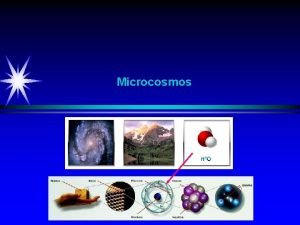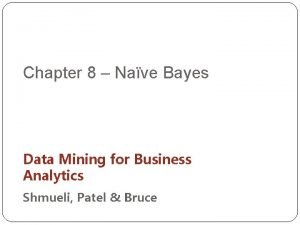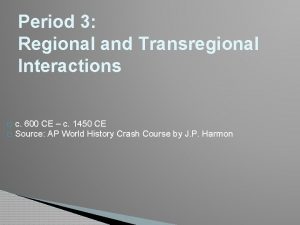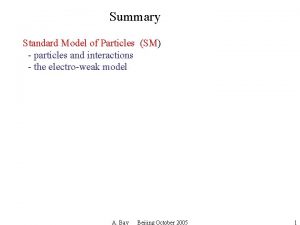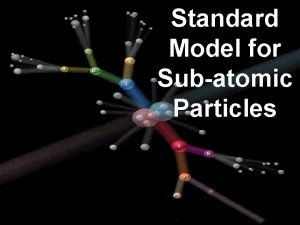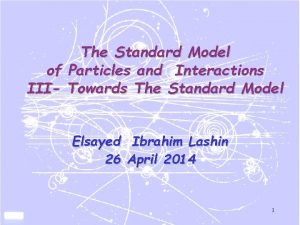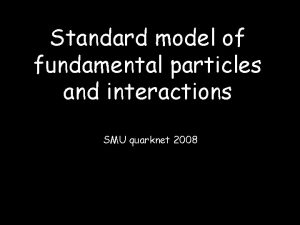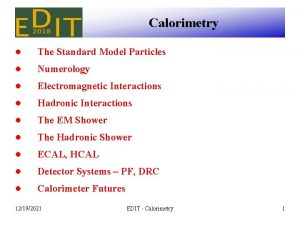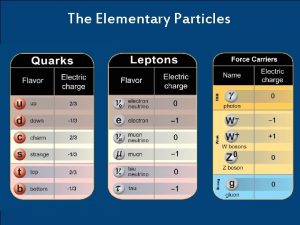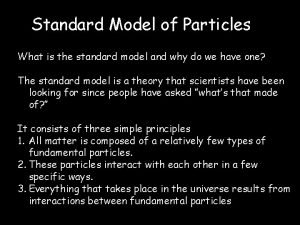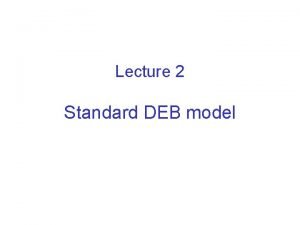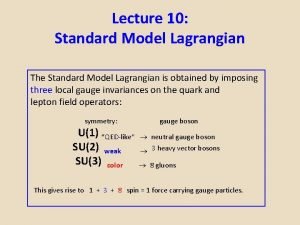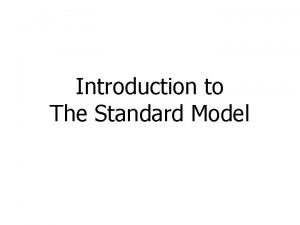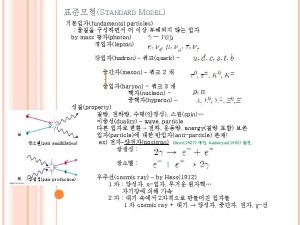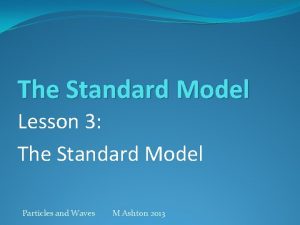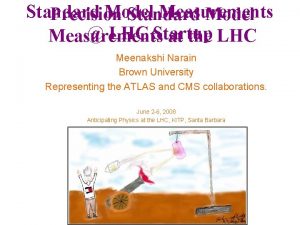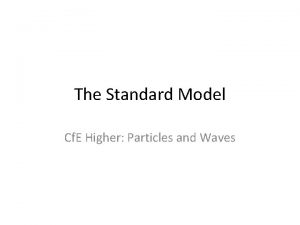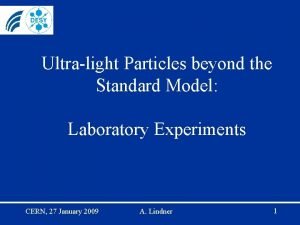The Standard Model of Particles and Interactions I



































- Slides: 35

The Standard Model of Particles and Interactions I- Introduction Elsayed Ibrahim Lashin 26 April 2014 1

Aims of Particle Physics 1. To understand nature at it’s most fundamental level. 2. What are the smallest pieces of matter, and how do they make up the large scale structures that we see today ? 3. How and why do these ‘fundamental particles’ interact the way that they do? 4. Understand the fundamental forces in nature. 2

The Elementary Blocks of Matter q. Matter is made of molecules q. Molecules are built out of atoms q. Atoms are made of nuclei and electrons q. Nuclei are assemblies of protons and neutrons q. Protons and neutrons are quarks bound together The volume of an atom corresponds to 10^24 times the volume of an electron. Classically, matter contains a lot of void Quantum mechanically, this void is populated by pairs of virtual pairs Of particles 3

Building blocks of matter 4

What IS Matter ? • Matter is all the “stuff” around you! Matter Hadrons Baryons Mesons Quarks Anti-Quarks Leptons Charged Neutrinos Forces Gravity Weak Strong EM 5

Force particles Matter particles Particles and Forces 6

Understanding building blocks I think I finally understand atoms 7

Plan to Introduce Particle Physics Lecture 1: Introduction to QFT, Relativity, Kinematics and Symmetries Lecture 2: Towards Gauge Theories Lectures 3: Towards the Standard Model 8

Why High Energies 9

What is Particle ?

Creation of Matter from Energy 11

Natural Units in High Energy Physics 12

Natural Units in High Energy Physics 13

Natural Units in High Energy Physics

Energy is concentrated! 15

Why Relativity 16

Relativistic Transformations 17

Implication of Lorentz Transformations 18

4 -Vectors 19

Energy-momentum four-vector Relativity allows for mass-less particle but moving with the velocity of light (Examples, Photon, …. . ) 20

Conservation of energy-momentum 21

Next step: marry quantum mechanics and relativity 22

Antimatter and Dirac equation 23

The necessity to introduce fields for a multiparticle description 24

Quantum Field Theory 25

Symmetries and conservation laws: the backbone of particle physics 26

27

28

Quantum numbers and Conservation laws 29

30

31

So why does matter appear to be so rigid ? Forces, forces !!!! It is primarily the strong and electromagnetic forces which give matter its solid structure. Strong force defines nuclear ‘size’ Electromagnetic force defines atomic ‘sizes’ 32

So why is this stuff interesting/important? q. All matter, including us, takes on its shape and structure because of the way that quarks, leptons and force carriers behave. q Our bodies, and the whole universe is almost all empty space ! q By studying these particles and forces, we’re trying to get at the question which has plagued humans for millenia … How did the universe start ? And how did we emerge from it all ? Where’s has all the antimatter gone ? 33

34

One of the most challenging questions physicists have been asking for ~45 years is: Why do the quarks & leptons have the masses that they do? Within the Standard Model of Particle Physics, there is a mechanism by which particles acquire their masses. A prediction of this “mechanism”, called the Higgs mechanism, is that there should exist a new particle, called the Higgs particle, H 0. This is not a quark, or lepton; it’s very different than any other particle we’ve talked about… If the Standard Model of Particle Physics is correct, we believe that this particle must exist…. experiments have searched for it, and have not found it so far mass must be very large. All we know so far is that mass of Higgs particle > 100 [Ge. V/c 235]
 Fundamental particles and interactions
Fundamental particles and interactions Accounting information system chapter 1
Accounting information system chapter 1 Words images objects qualitative or quantitative
Words images objects qualitative or quantitative Contractionary vs expansionary fiscal policy
Contractionary vs expansionary fiscal policy Properties and interactions of magnets
Properties and interactions of magnets Sphere interactions
Sphere interactions Chapter 6 lesson 1 habitats niches and species interactions
Chapter 6 lesson 1 habitats niches and species interactions Integral architecture example
Integral architecture example 4 factors facilitating communication
4 factors facilitating communication Symbiosis and species interactions keystone webquest
Symbiosis and species interactions keystone webquest Naive bayes pays attention to complex interactions and
Naive bayes pays attention to complex interactions and Modular product architecture
Modular product architecture Niches and community interactions
Niches and community interactions Regional and transregional interactions
Regional and transregional interactions Regional and transregional interactions
Regional and transregional interactions Standard error formula
Standard error formula Standard language and language standard
Standard language and language standard Characteristics of standard costing
Characteristics of standard costing Hát kết hợp bộ gõ cơ thể
Hát kết hợp bộ gõ cơ thể Lp html
Lp html Bổ thể
Bổ thể Tỉ lệ cơ thể trẻ em
Tỉ lệ cơ thể trẻ em Voi kéo gỗ như thế nào
Voi kéo gỗ như thế nào Chụp tư thế worms-breton
Chụp tư thế worms-breton Hát lên người ơi
Hát lên người ơi Các môn thể thao bắt đầu bằng tiếng chạy
Các môn thể thao bắt đầu bằng tiếng chạy Thế nào là hệ số cao nhất
Thế nào là hệ số cao nhất Các châu lục và đại dương trên thế giới
Các châu lục và đại dương trên thế giới Cong thức tính động năng
Cong thức tính động năng Trời xanh đây là của chúng ta thể thơ
Trời xanh đây là của chúng ta thể thơ Cách giải mật thư tọa độ
Cách giải mật thư tọa độ Làm thế nào để 102-1=99
Làm thế nào để 102-1=99 Phản ứng thế ankan
Phản ứng thế ankan Các châu lục và đại dương trên thế giới
Các châu lục và đại dương trên thế giới Thể thơ truyền thống
Thể thơ truyền thống Quá trình desamine hóa có thể tạo ra
Quá trình desamine hóa có thể tạo ra
